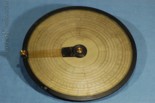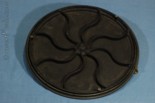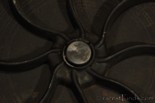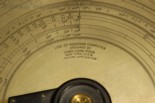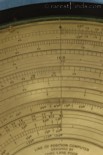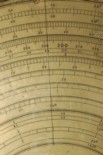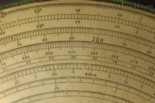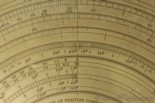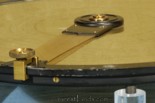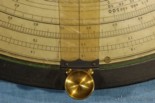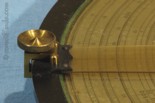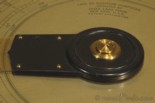Exceedingly rare antique "Line of Position Computer," invented by Prof. Dr. Charles Lane Poor. Sold!.
Patents, click on any image to see larger image!
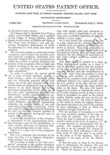
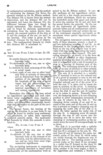
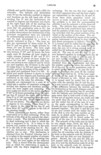
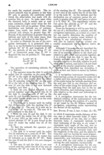
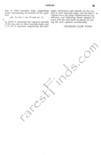

Line of Position Computer description:
This exceedingly rare navigation instrument is called "Line of Position Computer," and is essentially a mechanical navigator or circular slide rule for determining one's location, either from morning or afternoon sightings for longitude or from the St. Hilaire method of finding the line of position. It has a circular black lacquered cast aluminum frame or base, a green felt cushioning ring, an engraved brass disc, and a celluloid disc attached to a metal ring at the outer circumference. The brass lacquered and Celluloid arm that extends over the celluloid disc has a brass thumbscrew at the outer edge used to pin the arm to the metal ring that is attached to the Celluloid disk. The Celluloid disc and arm can therefore rotate together or independently, as needed.The brass disc is calibrated logarithmically in several concentric rings: from 80 to 0 degrees by minute in both directions (altitudes, adjusted by latitude and declination), from 0 to 500 by 1 (numbers), from 100/10/1 to 600/60/6 (logarithms), from 0 to 12 hours (hour angles), from 0 to 70 degrees by 1 X 2 (declinations), from I to XII by I (hour angles), and from 0 to 180 degrees (altitudes and azimuths).
According to instructions how to use the Poor computer which are part of the collection of Science & Mathematics at the National Museum of American History, Poor's computer was built in two sizes, for military aircraft and for battleships.
The instrument is engraved near the center:
DESIGNED BY
CHAS. LANE POOR
NEW YORK, U.S.A.
PATENT APPLIED FOR.
According to "The McNab Encyclopedia of Marine Appliances", by Alexander McNab, The McNab Company, Bridgeport, Connecticut, USA, three
different models were made and two different sizes of the basic model, Model 1 for private yachts, Model 2 for airplanes and smaller units
of the Nary, vessels of the mercantile marine, and aircraft; and Model 3 for the capital units of the Navy, and larger vessels
of the mercantile marine. Model 1 was manufactured in two different sizes, 12 and 15 inches in diameter; model 2 measured 13 inches, and
Model 3 was 19 inches in diameter. The model offered here has a diameter of 15 inches.
Poor's computers were sold by T. S. & J. D. Negus of New York City which was founded in 1850.
Despite the extensive references in the literature, Poor's Line of Position Computer was not a commercial success and only very few examples are known to exist, "[t]he scarcity of surviving examples suggests the government and general public had little interest in the instrument. Indeed, aviators preferred inspection tables over slide rules for navigation," The National Museum of American History. There is an example in the Smithsonian Institution in Washington, to see that example with a description click here!
Condition:
This fine example is in all original condition, free of defects or repairs of any kind.
History:
Charles Lane Poor (January 18, 1866 – September 27, 1951) was born in Hackensack, New Jersey, the son of Edward Erie Poor.
He graduated from the City College of New York and received a Ph.D. in 1892 from Johns Hopkins University. Poor became an
American astronomer and professor of celestial mechanics at Columbia University from 1903 to 1944, when he was named Professor
Emeritus. He published several books on astronomy and a monograph disputing the evidence for Einstein's theory of relativity in
the pre-war years before the
theory became firmly established. Poor published a series of papers that reflect his lack of understanding for the theory
of relativity.
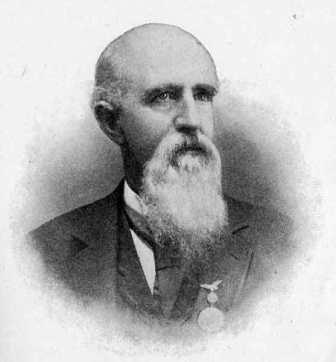
For 25 years, Poor held different positions as officer of the New York Yacht Club ("NYYC"). Poor was rubbing shoulders with many
influential personalities who were also officers of the NYYC at the same time, such as: Cornelius Vanderbilt, Commodore;
A Curtis James, Vice-Commodore; Frederick F. Brewster, Rear-Commodore; George A Cormack, Secretary;
Tarrant Putnam, Treasurer; H. de B. Parson, Ernest F. Lorillard and Walter C. Kerr, Regatta Committee;
Thomas A. Bronson, Hunter Wykes, and George A. Freeman, House Committee; Henry C. Ward, Edward F. Whitney,
Alexander S. Cochran, George A. Adee and George A. Armour, Committee on Admissions; Greenville Kane, Nelson Macy and James A Metcalf,
Library Committee; A. Bradlee Hunt, Paul E. Stevenson and James D. Sparkman, Model Committee; Augustus C. Taylor, Alfred C. Harrision,
Cord Meyer, Charles Lane Poor, Henry H. Rogers, Henry C. Ward, J. Harvey Ladew, Maximilian Agassiz, William H. Thomas,
William Lanman Bull and Paul G. Thebaud, Committee on Club Stations and Anchorages (the flag officers ex-officio); and last but
not least, Poor himself who was Measurer in 1906 of the NYYC.
Poor was also a Class A Governor of the Aero Club of America, 11E. 38th St. New York City, NY, and served together with other influential
personalities, such as Eddie Rickenbacker (Edward Vernon Rickenbacker, October 8, 1890 – July 23, 1973) who was an American fighter ace
in World War I and Medal of Honor recipient. With 26 aerial victories, he was America's most successful fighter ace in the war.
He was also a race car driver and automotive designer, a government consultant in military matters and a pioneer in air
transportation, particularly as the longtime head of Eastern Air Lines.
Poor in addition, was a fellow of the Royal Astronomical Society and an associate fellow of the American Academy of Arts and Sciences.
He served several terms as mayor of the town Dering Harbor on Long Island, New York, was an avid yachtsmen, and owned the yacht Myra.
His passion for yachting, astronomy, and science in general lead to his invention of the "Line of Position Computer" for maritime
and also for aviation navigation.
Poor received the US Patent number 1,308,748 issued July 1, 1919 for his invention, see images above.
At Columbia University, Poor was a teacher of the astronomer Samuel A. Mitchell, who went on to become director of the
Leander McCormick Observatory at the University of Virginia.
Poor's son, Edmund Ward Poor, was one of ten co-founders of Grumman Aircraft on Long Island.
Poor was an avid yachtsmen, owned the yacht Myra, and authored the book, "Men Against the Rule. A Century of Progress in Yacht Design," 1937. (only 950 copies were printed in the First Edition! However, the book is available as re-print)
References:
- Simplified Navigation for Ships and Aircraft, a text book based upon the Saint Hilaire Method
by Chas. Lane Poor, Professor of Celestial Mechanics in Columbia University, Author of "The Solar System," "Nautical Science," "Sumner Line Tables Simplified," etc., September 1918. To read the online copy of this book,
click here!
- Description with pictures of, "THE LINE OF POSITION COMPUTER" in "Air Service Information Circular" (Heavier-Than-Air) Published by the Director of Air Service, Washington, D.C., January 16, 1920, Vol.1, No.1, page 34 - 39. To read this description,
click here!
- Description and picture of "THE LINE OF POSITION COMPUTER" in "The McNab Encyclopedia of Marine Appliances", by Alexander McNab, The McNab Company, Bridgeport, Connecticut, USA. To read the online version of this book,
click here!
- Men Against the Rule. A Century of Progress in Yacht Design" by Charles Lane Poor 1937, republished in 2011, ISBN # 9781258020958
- "The Action of Jupiter upon Comet V. 1889." Thesis (Ph.D.) by Charles Lane Poor, 1892. Johns Hopkins University.
- "Gravitation versus Relativity," by Charles Lane Poor, 1922. To read the online version,
click here!
- Article about a club meeting of the NYYC in the magazine "Forest and Stream" issue of December 1, 1906, page 872. To read this article, click here!
- Test report about Poor's "LINE OF POSITION COMPUTER" in the "CARNEGIE INSTITUTION OF WASHINGTON, YEAR BOOK No.18, 1919, page 303. To read this report, click here!
- Report about Poor's "LINE OF POSITION COMPUTER" in "THE VARIATION OF AIROFOIL LIFT AND DRAG COEFFICIENTS WITH CHANGERS IN SIZE AND SPEED,
National Advisory Committee for Aeronautics, Report No. 111, 1921, page 38. To read this report,
click here!
- Obituary of Charles Lane Poor III (grandson of inventor). To read this obituary. click here!
Inventory Number 09242; package 7 lb, 16 by 16 by 6 inches.
Sold!
